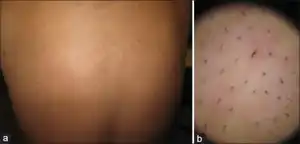Pili multigemini
| Pili multigemini | |
|---|---|
| Other names: Pili gemini[1] | |
| Specialty | Dermatology |
Pili multigemini, also known as "compound hairs,"[2] is a malformation characterized by the presence of bifurcated or multiple divided hair matrices and papillae, giving rise to the formation of multiple hair shafts within the individual follicles.[3][4]The name describes a condition where several separate hair fibers bunch together and emerge from the skin through a single hair canal. Pathology shows that deep in the skin several dermal papilla are closely situated with each producing a fiber, but these separate hair follicle bulbs combine together into one hair canal towards the skin surface. Folliculitis can sometimes be associated with this condition.[2]
Electrolysis will permanently remove pili multigemini. Depilating laser treatment has been suggested to improve symptomatic pili multigemini.[5]

See also
References
- ↑ Camacho-Martínez, Francisco (May 2012). "Orphanet: Pili gemini". www.orpha.net. Archived from the original on 12 January 2021. Retrieved 30 January 2020.
- 1 2 McElwee, Kevin J. "pili multigemini". www.keratin.com. Archived from the original on 2019-08-02. Retrieved 2019-10-28.
Pili multigemini hair follicles, also called 'compound hairs', are considered rare although there have been no studies to define the actual frequency in the general population, it is believed to be more common in men’s beards and children’s scalps.
- ↑ James, William; Berger, Timothy; Elston, Dirk (2005). Andrews' Diseases of the Skin: Clinical Dermatology. (10th ed.). Saunders. ISBN 978-0-7216-2921-6.
- ↑ Rapini, Ronald P.; Bolognia, Jean L.; Jorizzo, Joseph L. (2007). Dermatology: 2-Volume Set. St. Louis: Mosby. ISBN 978-1-4160-2999-1.
- ↑ Naysmith, L., De Berker, D. and Munro, C.S. (2001), Multigeminate beard hairs and folliculitis. British Journal of Dermatology, 144: 427–428. doi: 10.1046/j.1365-2133.2001.04047.x
External links
| Classification | |
|---|---|
| External resources |
|